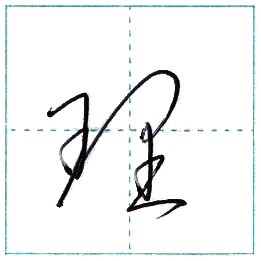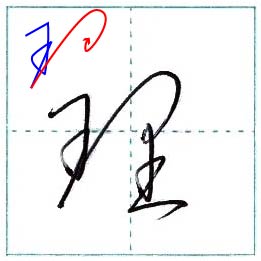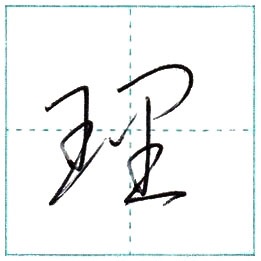今回と次回の記事で、草書の「理」を2種類紹介します。今回はそのPart.1です。
こんかいとじかいのきじで、そうしょの「理(り)」をにしゅるいしょうかいします。こんかいはそのパートワンです。
In this and the next article, I introduce 2 types of 理(ri) in cursive script. This time is the Part.1.

スポンサーリンク
草書は日常生活で書くことはなく、書道の作品でのみ使われています。
そうしょはにちじょうせいかつでかくことはなく、しょどうのさくひんでのみつかわれています。
We don’t write cursive script in daily life, it’s used only in calligraphy works.
単語例(たんごれい)
Word examples
修理 [しゅうり shuu ri] = repair
画像処理 [がぞうしょり ga zou sho ri] = image processing
無理 [むり mu ri] = impossibility
無理矢理 [むりやり mu ri ya ri] = forcibly, against one’s will
理不尽な [りふじんな ri fu jin na] = unreasonable
理性を失う [りせいをうしなう ri sei o ushina u] = to lose control of oneself
自己管理 [じこかんり ji ko kan ri] = self-control
義父 [ぎふ gi fu] / 義理の父 [ぎりのちち gi ri no chichi] = father-in-law
スポンサーリンク
書き順(かきじゅん)
Stroke order
1. この文字は、1画で書きます。
このもじは、いっかくでかきます。
Write this letter with one stroke.
1-1.

1-2.

1-3.

1-4.

1-5.

1-6.

1-7.

2. 完成(かんせい) Finish

公開日/post 2019.11.03
更新日/update 2019.11.03
スポンサーリンク


